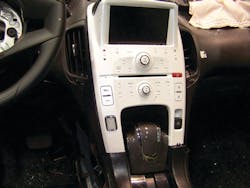SUBJECT: Electric Vehicles
TOPIC: Part 3 – 2011 Chevrolet VOLT Battery
OBJECTIVE: Given a potential crash scenario involving a 2011 Chevrolet VOLT, the emergency responder will understand recommended safety management procedures.
TASK: The rescue team shall study the information provided and create a department guideline for initial safety management including vehicle stabilization and power shutdown of a Chevrolet VOLT involved in a vehicle crash incident.
In part three of our series on the Chevrolet VOLT, we will outline recommended safety management procedural steps that should be undertaken by responders arriving at a vehicle crash where a VOLT is involved. Although these tasks are appropriate for a VOLT, the original seven-step procedure featured here was first introduced in 2001 by this author for use in safety management of gasoline-electric hybrid vehicles. It remains a relevant and comprehensive guideline for handling any hybrid vehicle emergency as well as the new generation of all-electric drive vehicles that are being introduced in the United States. Responders should understand the purpose for each of the seven steps and then implement them as appropriate when arriving at an electric vehicle crash or fire incident.
The key words to identify the seven steps of the electric vehicle Lock-Out/Tag-Out protocol are Identification, Stabilization, Access, Parking, Ignition, Instrument Panel, and Electrical System Shutdown.
Identification
For responders summoned to an incident where a Chevrolet VOLT is involved, identification can occur in two different ways. All VOLT vehicles are provided with a complimentary one-year subscription to ONSTAR. With this very advanced telemetry system, the ONSTAR advisor will be automatically notified of a crash involving a VOLT. The advisor will be able to communicate with the occupants, pinpoint the exact location of the vehicle, obtain crash information and potential injury data, and notify the local communications center capable of dispatching the appropriate responder agencies — police, fire, medical, tow/recovery.
Once at the scene of the incident, identification of a car as the VOLT is accomplished by looking for the VOLT name, called a "badge," on any of three sides of the vehicle. The three-sided VOLT badging exists on the rear hatchback and on both front fenders of the car.
Stabilization
The second step of the safety management protocol for dealing with the VOLT plug-in electric vehicle is vehicle stabilization. Upon your arrival, the car will be absolutely silent. Silence for a conventional automobile typically means that its engine is shut off. Not so with an all-electric automobile. Stay away from the front of the vehicle initially. Use cribbing or wheel chocks at either front-drive wheel to prevent the vehicle from moving forward or rearward. Then for a vehicle on four wheels sitting on a level surface, place cribbing or stepchocks beneath the vehicle to stabilize it as you prepare to enter and attend to the occupants inside.
If your patient will simply be packaged and removed from the vehicle, then chocking and blocking is most likely sufficient stabilization. If rescue and extrication tools will be committed to the car, then in addition to basic chocking and blocking of the car, all tires should be deflated to settle the weight of the car onto the cribbing. "Chock, Block and Blow" is the recommended practice to follow when extrication is required. For a side-resting or roof-resting VOLT, use stabilization struts to assist in stabilizing the vehicle.
Access
The third step in the VOLT safety management protocol is access to the interior. Try any of the four doors first. Most likely, with approximately 80% of the structure steel being advanced steels, multiple doors will readily open. If a door opens, fine. If all the doors for some reason are obstructed, then go for a tempered-glass side window or rear hatchback glass. It is all tempered. Make a quick access opening to allow EMS personnel to get inside with the occupants who are now your patients.
Park & Parking Brake
As soon as interior access is gained by any responder, place the gear selector lever into the "P" or "Park" position by moving it forward. It is in the center of the center console and is readily identifiable. Then, activate the electric parking brake by pressing the button on the right side of the center console. It is labeled with a "P" surrounded by a circle. This ensures that the VOLT will remain where it is if it is on its four wheels and has been stabilized.
Ignition
Step five of our VOLT Lock Out/Tag Out process is very important. The inside medic or rescuer must turn the ignition of the VOLT off or verify that it is already off. There is no ignition key and no ignition switch on the side of the steering column. Instead, the VOLT has a push-button ignition switch on the left side of the center console. It is labeled with the words "START" and "STOP." If the ignition is on, then one more push will turn the ignition off. When the ignition is off, the high-voltage power for the electric drive system shuts down and is isolated to just the high-voltage battery itself.
Instrument Panel
After turning the ignition to the off position, the interior rescuer should glance across the instrument panel. There should be no dial or gauge with any needle or indicator showing that the vehicle is running or on. If you followed the first five steps then at this point, the instrument panel will indicate that the VOLT is now turned off. Once the VOLT is turned off, the airbag capacitor begins draining as well.
12-volt Shutdown
If your VOLT crash incident is minor or if occupants need only routine EMS procedures to package and remove them from the vehicle, then you may decide to stop at this point in the process. If however, the decision is made that you want the 12-volt electrical system shutdown, then you must accomplish Step 7 of our protocol; 12-volt shutdown. On the VOLT, you have two choices. For power shutdown when time is not critical, you can access the battery beneath the floor of the rear cargo area. The terminals for both hot and ground cables are accessible and can be disconnected from the battery terminals without damage to the cabling.
If 12-volt power shutdown is needed immediately, a responder standing at the rear hatchback area can open an interior access panel on the left side and locate the bright-yellow responder "Cut Here" label. It is taped to the hot cable wiring bundle coming from the 12-volt battery. Cutting once above this label and then a second time below the label, a "double cut," will remove a section of the 12-volt electrical system's hot cable, shutting down 12-volt power and also the 360-volt high voltage throughout the car.
The 360-volt lithium ion battery shuts down when the ignition is turned off, when any of the eight airbags deploy, or when the 12-volt power is taken away. Inside the center console storage bin is a large orange plug. This safety device is called the "Manual Service Disconnect" and is designed to be readily removed by repair technicians. If responders want to be redundant, they can open the storage bin and unlatch then remove this manual disconnect. This reassures that all high-voltage current is isolated to just the lithium ion battery.
Remember, because the VOLT is an extended-range, plug-in electric vehicle, it has an onboard electric generator that is fueled from an eight-gallon gasoline tank. The tank is pressurized slightly. A familiar-looking fuel filler door and gasoline fill tube is on the right side, rear fender area of the VOLT.
TASK: The rescue team shall study the information provided and create a department guideline for initial safety management and power shutdown of a Chevrolet VOLT involved in a vehicle crash incident.
Read the rest of the series here:
RON MOORE, a Firehouse® contributing editor, is training chief for the McKinney, TX, Fire Department. He also authors a monthly online article in the Firehouse.com "MembersZone" and serves as the Forum Moderator for the extrication section of the Firehouse.com website. Moore can be contacted directly at [email protected].
About the Author
Ron Moore
RON MOORE, who is a Firehouse contributing editor, recently retired as a division chief with the McKinney, TX, Fire Department and now serves with Prosper, TX, Fire Rescue. He self-published the Vehicle Rescue 1-2-3 training manual and serves as the forum moderator for the extrication section of Firehouse.com . Moore can be contacted directly at [email protected].

